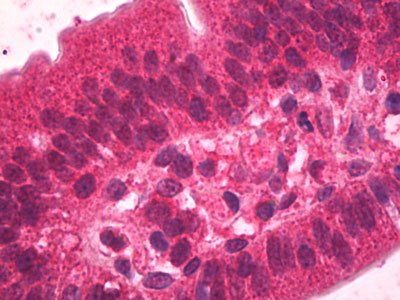HNF4A / HNF4 Antibody (N-Terminus)
Goat Polyclonal Antibody
- SPECIFICATION
- CITATIONS
- PROTOCOLS
- BACKGROUND

Application
| WB, IHC-P, E |
|---|---|
| Primary Accession | P41235 |
| Reactivity | Human, Rabbit, Hamster, Monkey, Pig, Horse, Dog |
| Host | Goat |
| Clonality | Polyclonal |
| Calculated MW | 53kDa |
| Dilution | ELISA (1:32000), IHC-P (2 µg/ml), WB (0.1-0.3 µg/ml) |
| Gene ID | 3172 |
|---|---|
| Other Names | Hepatocyte nuclear factor 4-alpha, HNF-4-alpha, Nuclear receptor subfamily 2 group A member 1, Transcription factor 14, TCF-14, Transcription factor HNF-4, HNF4A, HNF4, NR2A1, TCF14 |
| Target/Specificity | Human HNF4A / HNF4. This antibody is expected to recognise the reported isoforms a, b and c (NP_849180.1; NP_000448.3; NP_849181.1 resp.). |
| Reconstitution & Storage | Short term 4°C, long term aliquot and store at -20°C, avoid freeze thaw cycles. |
| Precautions | HNF4A / HNF4 Antibody (N-Terminus) is for research use only and not for use in diagnostic or therapeutic procedures. |
| Name | HNF4A |
|---|---|
| Synonyms | HNF4, NR2A1, TCF14 |
| Function | Transcriptional regulator which controls the expression of hepatic genes during the transition of endodermal cells to hepatic progenitor cells, facilitating the recruitment of RNA pol II to the promoters of target genes (PubMed:30597922). Activates the transcription of CYP2C38 (By similarity). Represses the CLOCK-BMAL1 transcriptional activity and is essential for circadian rhythm maintenance and period regulation in the liver and colon cells (PubMed:30530698). |
| Cellular Location | Nucleus. |

Thousands of laboratories across the world have published research that depended on the performance of antibodies from Abcepta to advance their research. Check out links to articles that cite our products in major peer-reviewed journals, organized by research category.
info@abcepta.com, and receive a free "I Love Antibodies" mug.
Provided below are standard protocols that you may find useful for product applications.
Background
Transcriptionally controlled transcription factor. Binds to DNA sites required for the transcription of alpha 1- antitrypsin, apolipoprotein CIII, transthyretin genes and HNF1- alpha. May be essential for development of the liver, kidney and intestine.
References
Kritis A.A.,et al.Gene 173:275-280(1996).
Drewes T.,et al.Mol. Cell. Biol. 16:925-931(1996).
Yamagata K.,et al.Nature 384:458-460(1996).
Tanaka T.,et al.Submitted (JUL-2004) to the EMBL/GenBank/DDBJ databases.
Deloukas P.,et al.Nature 414:865-871(2001).
If you have used an Abcepta product and would like to share how it has performed, please click on the "Submit Review" button and provide the requested information. Our staff will examine and post your review and contact you if needed.
If you have any additional inquiries please email technical services at tech@abcepta.com.













 Foundational characteristics of cancer include proliferation, angiogenesis, migration, evasion of apoptosis, and cellular immortality. Find key markers for these cellular processes and antibodies to detect them.
Foundational characteristics of cancer include proliferation, angiogenesis, migration, evasion of apoptosis, and cellular immortality. Find key markers for these cellular processes and antibodies to detect them. The SUMOplot™ Analysis Program predicts and scores sumoylation sites in your protein. SUMOylation is a post-translational modification involved in various cellular processes, such as nuclear-cytosolic transport, transcriptional regulation, apoptosis, protein stability, response to stress, and progression through the cell cycle.
The SUMOplot™ Analysis Program predicts and scores sumoylation sites in your protein. SUMOylation is a post-translational modification involved in various cellular processes, such as nuclear-cytosolic transport, transcriptional regulation, apoptosis, protein stability, response to stress, and progression through the cell cycle. The Autophagy Receptor Motif Plotter predicts and scores autophagy receptor binding sites in your protein. Identifying proteins connected to this pathway is critical to understanding the role of autophagy in physiological as well as pathological processes such as development, differentiation, neurodegenerative diseases, stress, infection, and cancer.
The Autophagy Receptor Motif Plotter predicts and scores autophagy receptor binding sites in your protein. Identifying proteins connected to this pathway is critical to understanding the role of autophagy in physiological as well as pathological processes such as development, differentiation, neurodegenerative diseases, stress, infection, and cancer.


